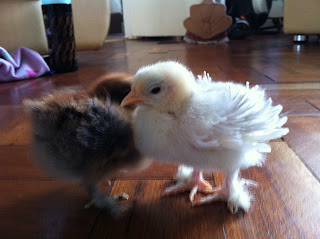Here they are at a couple of days old;
 |
| One week (ish) |
 |
| Two weeks (ish - you get the idea) |
 |
| Roughly 4 weeks |
At four weeks they have a good smattering of feathers, rather than a fuzzy covering. They are still eating Chick Crumb but also mashed up boiled egg, including the shells and mealworms, yeuck! Coincidently, did you know mealworms can be bought off the shelf in 'mini', 'medium' and 'there's no way I'm going to buy THOSE' sizes from a pet shop near you.
When starting to feed your chicks other foodstuff, you do need to add grit, in the case of chicks, chick grit. This helps to grind up the food when it leaves your chicken's crop. Here's an accurate description about the function of the crop and grit from Queensland Government Primary industries & fisheries, including long words that I probably wouldn't have used.
'The crop is a temporary storage pouch at the base of the neck that sends the hunger signal to the brain. The oesophagus then traverses the chest cavity to carry food to the proventriculus where food is mixed with acids and other digestive enzymes. Retention time here depends on the activity of the crop and gizzard. Grit in the gizzard, combined with strong muscular action, grinds the food into a mash.'
At 4 weeks, their acquired brooder was getting a little snug. The hunt was on for an equally cost effective (free) indoor home for them as I had planned to move them out to their (yet to be bought, or even decided upon) coop at 7 weeks. As luck would have it, my husband in his recent flurry of purchasing musical equipment had bought something that required a ginormous cardboard box. It was duly acquired and with everything transferred over the chicks soon settled into their new home, with the mandatory hour of concerned cheeping.
The writing that you can see a bit of is a line from Louis Jordan's 'There Ain't Nobody Here But Us Chickens'. A rather amusing song that seems to get sung round the house quite a lot these days. Bonus points if you spotted that there are two lamps on the brooder. I couldn't decide whether to go with a new red bulb, or stick with the clear which I had been successfully using for the previous four weeks. In my indecision I thought I'd let the chicks decide but they were equally undecided, so I stuck with the clear.
The daily cockerel/hen checks were picking up speed at this point. I was fairly sure that Brick was a hen but less sure about Betty. Needless to say, a lot of checking on various forums and googling pictures of chicks at various ages of development took place. Cockerels' combs and wattles (the sticky out areas of featherless skin on top of their heads and under their beaks), grow quicker and larger than hens, and whereas hens' combs and wattles tend to stay pinky/yellow (until point of lay I think), cockerels' start to redden up. So at 4 weeks, the jury was still out.
When starting to feed your chicks other foodstuff, you do need to add grit, in the case of chicks, chick grit. This helps to grind up the food when it leaves your chicken's crop. Here's an accurate description about the function of the crop and grit from Queensland Government Primary industries & fisheries, including long words that I probably wouldn't have used.
'The crop is a temporary storage pouch at the base of the neck that sends the hunger signal to the brain. The oesophagus then traverses the chest cavity to carry food to the proventriculus where food is mixed with acids and other digestive enzymes. Retention time here depends on the activity of the crop and gizzard. Grit in the gizzard, combined with strong muscular action, grinds the food into a mash.'
At 4 weeks, their acquired brooder was getting a little snug. The hunt was on for an equally cost effective (free) indoor home for them as I had planned to move them out to their (yet to be bought, or even decided upon) coop at 7 weeks. As luck would have it, my husband in his recent flurry of purchasing musical equipment had bought something that required a ginormous cardboard box. It was duly acquired and with everything transferred over the chicks soon settled into their new home, with the mandatory hour of concerned cheeping.
The writing that you can see a bit of is a line from Louis Jordan's 'There Ain't Nobody Here But Us Chickens'. A rather amusing song that seems to get sung round the house quite a lot these days. Bonus points if you spotted that there are two lamps on the brooder. I couldn't decide whether to go with a new red bulb, or stick with the clear which I had been successfully using for the previous four weeks. In my indecision I thought I'd let the chicks decide but they were equally undecided, so I stuck with the clear.
The daily cockerel/hen checks were picking up speed at this point. I was fairly sure that Brick was a hen but less sure about Betty. Needless to say, a lot of checking on various forums and googling pictures of chicks at various ages of development took place. Cockerels' combs and wattles (the sticky out areas of featherless skin on top of their heads and under their beaks), grow quicker and larger than hens, and whereas hens' combs and wattles tend to stay pinky/yellow (until point of lay I think), cockerels' start to redden up. So at 4 weeks, the jury was still out.










